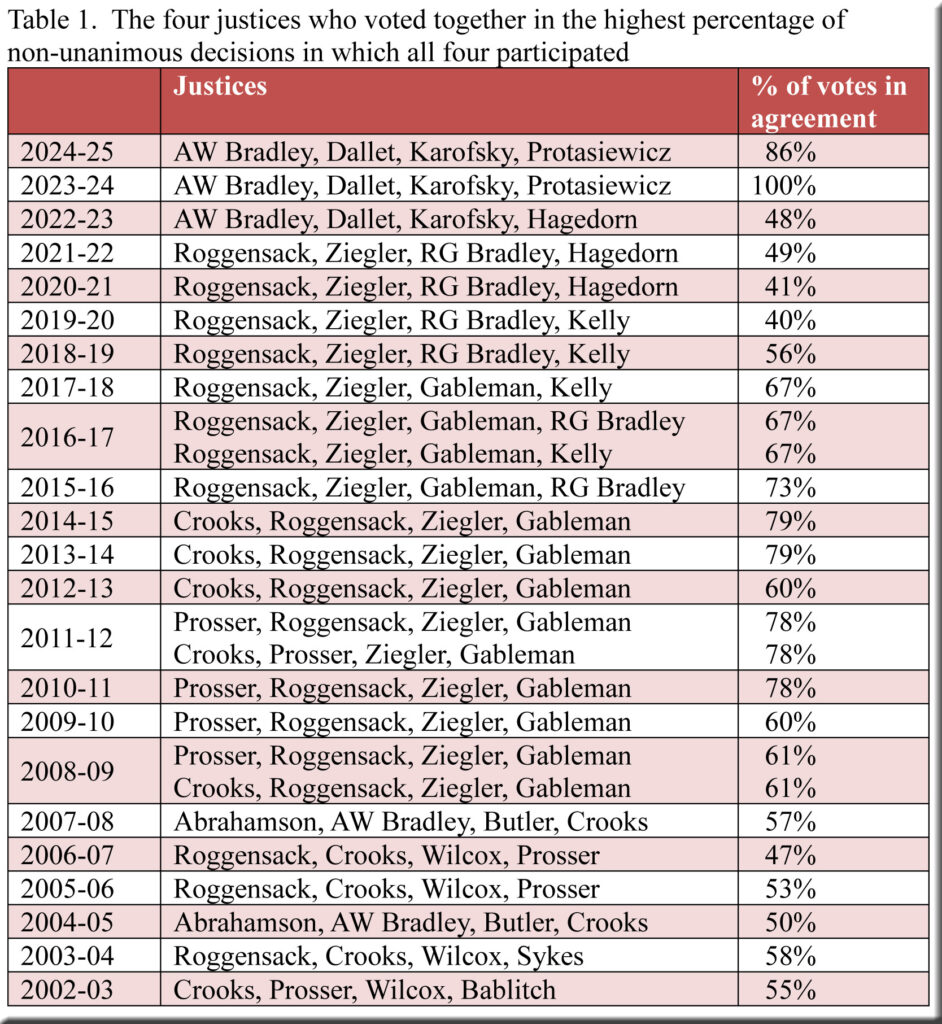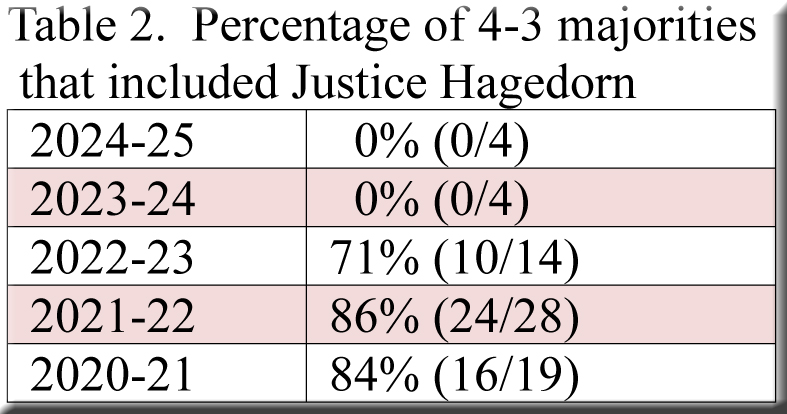One of last year’s posts could have been titled “The Rise of the Liberals,” as we examined evidence of the court’s new liberal sway shortly after years of conservative ascendancy. Certain indications of this sea change were unprecedented, and the fact that the court’s composition has not altered suggests that similarly noteworthy features are likely to characterize our findings for 2024-25.
Bloc cohesion
Apart from the extraordinarily small number of decisions, perhaps the most striking item in last year’s posts pertained to bloc cohesion among the four liberals. At no other time over the past century have four justices voted in agreement in every case—until 2023-24, when Justices AW Bradley, Dallet, Karofsky, and Protasiewicz did so. And they came very close in 2024-25, voting together in 20 of 22 cases (with Justices Karofsky and Protasiewicz each dissenting once).
Even if we confine ourselves to the 14 non-unanimous decisions, the rate of agreement among the four liberals was extremely high in 2024-25, 86%—exceeding that for any other quartet of justices (other than the same four in 2023-24) throughout the 23 terms covered in Table 1.
Only Justices Ziegler and RG Bradley could match the liberals’ cohesion, voting together in 92% of non-unanimous cases where both participated, but they could rarely attract the two additional votes needed to prevail. Even one more vote, that of Justice Hagedorn, proved elusive, as he joined them in just 46% of these cases.[1]
Justice Hagedorn
For three terms, 2020-21 through 2022-23, Justice Hagedorn’s vote was crucial in most 4-3 decisions, as noted in previous posts. During these years the court’s three liberals (Justices AW Bradley, Dallet, and Karofsky) and its three conservatives (Justices Roggensack, Ziegler, and RG Bradley) each needed to win the vote of Justice Hagedorn in order to form a majority in contentious cases. Sometimes he voted with the liberals and sometimes with the conservatives, but either way he appeared in most 4-3 majorities.
That evaporated in 2023-24, after Justice Protasiewicz replaced Justice Roggensack. The liberals could now navigate without Justice Hagedorn, and he vanished entirely from 4-3 majorities. He did so again in 2024-25 (Table 2), scarcely surprising with the same seven justices on the bench.
Not only Justice Hagedorn
Viewing the court’s history more broadly, we find other justices who also experienced drastic changes in their influence over the years. As an example, let’s focus on the three current justices—AW Bradley, Ziegler, and RG Bradley—who served during four years of conservative dominance (2015-16 through 2018-19)[2] and during the last two years, when liberals gained the upper hand.
During the “conservative era,” Justice AW Bradley, a liberal, surfaced in only about a third of the majorities in non-unanimous decisions, far below the percentages for the two conservatives, Justices Ziegler and RG Bradley (Table 3). How overwhelming, then, was the reversal in the justices’ roles that arrived a few years later with the new liberal primacy. Justice AW Bradley, usually a dissenter in non-unanimous cases during the first four years in the table, voted with the majority every time in both 2023-24 and 2024-25. Meanwhile, Justices Ziegler and RG Bradley, routinely in majorities during the conservative zenith, saw their percentages plummet—as low as 14% for Justice RG Bradley in 2024-25 and 0% for Justice Ziegler in 2023-24.[3]
Coming next
Much more information is available regarding the 2024-25 term, and next week we’ll have a look at several topics—particularly those related to the votes and alignments of individual justices.
[1] Justice Ziegler did not participate in one of the 14 non-unanimous cases. Of the remaining 13 non-unanimous cases, she and Justice RG Bradley voted together in 12, and Justice Hagedorn joined them in six of the 13.
[2] The following justices served during these four “conservative terms”: 2015-16—Justices Abrahamson, AW Bradley, Prosser, Roggensack, Ziegler, Gableman, and RG Bradley; 2016-17 and 2017-18—Justices Abrahamson, AW Bradley, Roggensack, Ziegler, Gableman, RG Bradley, and Kelly; and 2018-19— Justices Abrahamson, AW Bradley, Roggensack, Ziegler, RG Bradley, Kelly, and Dallet.
[3] Click here for a table covering every year from 2015-16 through 2024-25.



Speak Your Mind